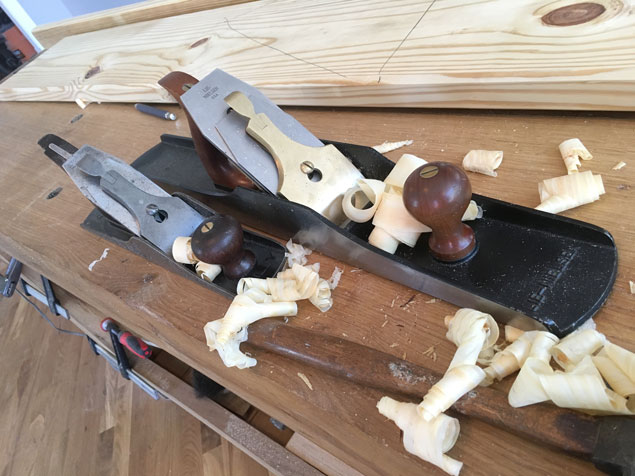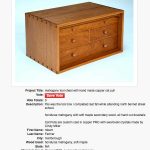We may receive a commission when you use our affiliate links. However, this does not impact our recommendations.
I suspect this will ruffle a few feathers, but so be it.
I’ve been asked a lot lately if one really needs a jack and a jointer plane. Several well-respected woodworkers and writers now teach that you can prepare all your stock for finishing with only one bench plane, a smoothing plane, if you use machine-prepared stock.
I suppose that’s true in the same way that I could write all my blog entries with a manual typewriter, scan them and then use optical character recognition to prepare them for the Internet. Yes, you can do it, but you will get a lot more done if you use the tool that was designed for what you are trying to accomplish.
Like most woodworkers, I use machines to prepare my rough stock, but then my hand tools take over to get things flatter than the machine can (thank you, jointer plane), cut the joinery and prepare things for finishing.
That short statement is nice and tidy, but it really doesn’t help you, does it? The more helpful explanation is messier and longer. Sorry. But learning patience and complexity is an important part of the craft you signed up for.
So first let’s discuss the much-maligned jointer/try plane – the longest plane in the shop.
Jointer (aka Try) Planes
Let’s say I asked you to build me new kitchen cabinets (and fulfill my wife’s wildest fantasy). But I said you could use only a 6” ruler for marking and measuring. You could do it. And if you were really good, you’d probably manage just fine. But it wouldn’t be easy, especially when you were dealing with any measurement more than 6”.
The same idea is true with handplanes. You could use a 9”-long smoothing plane to true an 8’-long edge. But it takes a lot of skill and attention. But when you switch to a 24”-long try or jointer plane, then it becomes child’s play. The long sole virtually guarantees a high level of accuracy.
I find that any handplane can easily straighten a surface that is twice the length of its sole. A 9”-long plane is good for wood that is 18” long. A 24”-long plane is good for wood that is 48” long – and 48”-long boards are typical in furniture-making.
Like your straightedge, your jointer plane is your guarantee that a surface is flat. The difference is that the jointer plane can make a surface flatter. A straightedge is impotent at this task.
When I talk to people who use only a smoothing plane (which is the least-used plane in my shop) I imagine they build only small things. It helps me sleep at night.
The Jack Plane
I am deeply suspicious of anyone who won’t spend $20 to own a jack plane that can last them the rest of their lives. Armed with an iron that has a curved cutting edge (an 8” or 10” radius is typical), you can achieve superhuman feats with your jack.
Need to remove 1/4” of wood on one area of a board’s edge? The jack plane will laugh at that task, where an electric jointer or smoothing plane would struggle. The jack literally eats wood for breakfast (and lunch and dinner, elevensies, supper, snack-time, and etc.).
You don’t have to be strong to wield it. The curved iron (and working across the grain) makes it an easy tool to use.
I use my jack plane more than any other plane in my chest.
Example: Say I need to bevel the underside of a tabletop. I could do that with a smoothing plane. But a jack will waste away the wood in seconds. The smoothing plane can clean things up later and take the glory.
Need to remove twist from a rough board? The jack (worked diagonally across two high spots) will make things true before your smoothing plane can even get started. Need to waste wood away for a moulding? For a saddled seat? For bevels or chamfers of any angle? To fit a moulding against an irregular plastered wall? Jack is your friend. It doesn’t need a flat sole, a fancy iron or cap iron. Just a sharp and curved cutting edge will do the job.
Not My Idea
Using three planes – jointer, jack and smoother – is an idea that is as old as Western woodworking. Even when machines began taking over the grunt work, woodworkers of all stripes found that these three planes made their workshop lives a lot easier.
That’s why you’ll find so many used jack and jointer planes that are metallic. Think about it: When Stanley started cranking out millions of planes using automated machinery, that same automated machinery had made it easy to process rough timber into flat boards.
Yet even then, jack and jointer planes were still essential. Even in shops where machinery did the donkey work.
I think that’s worth thinking about.
— Christopher Schwarz
Here are some supplies and tools we find essential in our everyday work around the shop. We may receive a commission from sales referred by our links; however, we have carefully selected these products for their usefulness and quality.












I make guitars so most of my work is relatively small. I have an old DR Barton fore plane that is 19″ long and massively made of what I think is mahogany – a really elegant wooden plane.
At 19″ I figure it’s long enough for jointing guitar tops and short enough to use for general jack plane work, but sometimes I get the itch for another plane, figuring it might be too massive for a jack or too small for a true jointer.
So far I manage but wondered if there were any opinions. Unlike others I do not just buy every plane available lol.
I don’t recall having seen you comment or write about scrub planes (i.e. Stanley #40). With its radically curved and narrow blade, a scrub can really hog away material. The way you you set up and use the jack (#5) is similar to the ways a scrub plane is used.
Do you see the scrub as occupying a different place? Or, just a more specialized version of the jack?
I think I own a jack plane…..its a Fulton No.5262. Its not a well made tool but has a good iron. I use it to take off high spots if too wide for the joiner. I would use it more if I could locate a front tote screw. Now I have to jam a small brass screw in the hole. It holds awhile but works loose with some vigorous planning. Searches for a replacement are all dead ends. Anybody know a fix?
Great post, and I couldn’t agree more. Although I work exclusively with wooden bodied planes, this still holds true. My work is sporadic, but I gravitated to the “right” planes as I did more work. My wooden smoother is very finely tuned, and is very similar in size to a metal #2 or #3, except a bit wider. It puts a fine finish on a surface. My wooden jack has a more open throat, a curved iron, and is 15″ long, just about like a metal #5. It removes wood fast, and sees the most use. My go-to wooden jointer is 28″ long, and makes quick work of truing an edge or flattening a face. The closest metal equivalent is a #8, which is generally a little shorter. I feel like I’m missing the equivalent to a metal #7, which I would call a fore plane. I have a wooden plane 22″ long, but need to tune it up. I would likely use it more often than my 28″ jointer if it were tuned up, especially on faces. I’d save the jointer mostly for edges. An upside to the metal planes is that they are probably much more available in good condition than wooden bodied planes. Wooden ones are out there though if you prefer them.
Both tradition and experience testify to the truth of what Chris is saying. But I wonder about one detail. For a jointer, why choose a No. 8 rather than a No. 7, as Chris seems to have done? Certainly the abundance of smoothers, jacks and jointers on the used tool market testify to their ongoing utility over the years. But No. 7s are far more abundant than No. 8s. In this case Chris seems to be going against the weight of tradition, by choosing the bigger jointer. I’m just wondering why.
My jointer sits in its place of honor in my tool chest. It was one of the first three planes I bought almost 30 years ago now (for some reason I bought a jointer, jack, and smoother, even though I really didn’t know why back then). I use it every bit as much as the other two. It’s invaluable for taking down the high spots left by my cambered iron jack plane. On boards larger than 12″, it can’t be beat for giving me a dead flat surface. I use it to joint a long edge, and on my shooting board to clean up a rough end. It is every bit as indispensable as either of the other two planes. If you don’t have one, get one. You’ll wonder how you ever lived without it.
I would argue that the Jack plane is really best served as a pre-machine plane. If you use rough lumber then what Chris notes about twist and high corners is what the jointer-planer can not deal with well – at least without a sled. The jack will help remove the twist and high spots letting you get your rough boards to the machines. Then go back to the jointer or smoothing plane for finish work depending on the length. Just set up the plane and blade for finish work.
Hey Chris
A long time ago you wrote an article and later made a DVD,called Coarse, Medium. and Fine. It’s a longer version of what you’re talking about. Sure you can use a smoothing plane to take 1/8-1/4 inch of material but it would take forever. Where a coarse or Jack plane would take a fraction of the time. That article changed the way I worked and I’ll bet it did the same for anyone who read the article and or saw the DVD.
HAPPY FATHERS DAY
Michael Rogen
I think that you have to keep pounding into our heads that the jack plane is a roughing tool! More pounding!
For me at least, it’s hard to remember that iron with the 8″ curve for the jack plane is there when I need it to quickly remove a lot of wood. Somewhere, deep in my psyche is the embedded notion that the hand plane is a precision tool.
I do have a nice sharp iron with an 8″ curve – it’s wrapped in “no rust” paper in a drawer in my tool box. Out of sight, out of mind I guess.
I just hung a new door in my bathroom and needed to trim the door to fit the 70 year old house’s opening. Nothing is quite square in an older house, so take off 1/4″ on a slant here, 1/8″ on a slant there, and then make the whole thing 1/4″ smaller. I did use my jack plane to do this but with a smooth plane’s barely curved iron shape at .002″ a stroke. The door looks great. It took forever! Were I doing this for a living my children would starve.
I have another door to do – now where exactly is that iron with the 8″ curve on it.
I consider myself a novice woodworker. I’ve been at, now, for almost ten years (sporadically). I do not yet own a jointer plane. I was gifted a beat up old jack and have got the sole fairly flat (I didn’t know it didn’t need to be), have some curve to the edge and gotten it fairly sharp. I’ll probably use it for its intended purpose for the first time, this week, to level out the high spots on a laminated construct I’m attempting. Since there is some end grain involved, I don’t see any other way to do it (Oh I know, I could fire up the belt sander.)